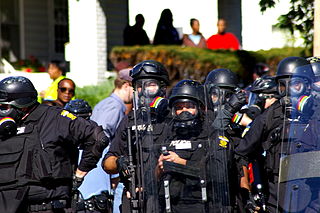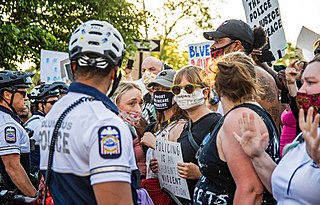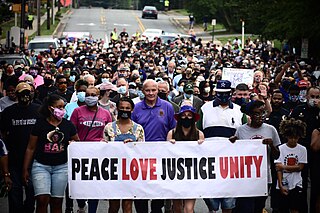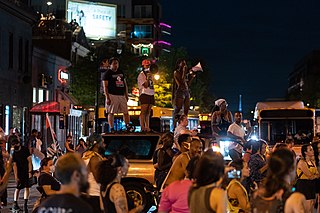The 1991 Washington, D.C., riot, sometimes referred to as the Mount Pleasant riot or Mount Pleasant Disturbance, occurred in May 1991, when rioting broke out in the Mount Pleasant neighborhood of Washington, D.C., in response to an African-American female police officer having shot a Salvadoran man in the chest following a Cinco de Mayo celebration.
The Baltimore riot of 1968 was a period of civil unrest that lasted from April 6 to April 14, 1968, in Baltimore. The uprising included crowds filling the streets, burning and looting local businesses, and confronting the police and national guard.

The 2005 Toledo riot, on October 15, 2005, occurred when the National Socialist Movement (NSM), a neo-Nazi organization, planned a march to protest African-American gang activity in the North End of Toledo, in the U.S. state of Ohio. The appearance of the group sparked a four-hour riot by elements within the assembled protesters, and caused a citywide curfew to be implemented for the remainder of the weekend.
The Tompkins Square Park riot occurred on August 6–7, 1988 in Tompkins Square Park, located in the East Village and Alphabet City neighborhoods of Manhattan, New York City. Groups of "drug pushers, homeless people and young people known as squatters and punks," had largely taken over the park. The East Village and Alphabet City communities were divided about what, if anything, should be done about it. The local governing body, Manhattan Community Board 3, recommended, and the New York City Parks Department adopted a 1 a.m. curfew for the previously 24-hour park, in an attempt to bring it under control. On July 31, a protest rally against the curfew saw several clashes between protesters and police.
The Louisville riots of 1968 refers to riots in Louisville, Kentucky in May 1968. As in many other cities around the country, there were unrest and riots partially in response to the assassination of Martin Luther King Jr., on April 4. On May 27, a group of 400 people, mostly blacks, gathered at 28th and Greenwood Streets, in the Parkland neighborhood. The intersection, and Parkland in general, had recently become an important location for Louisville's black community, as the local NAACP branch had moved its office there.

Avondale is a neighborhood in Cincinnati, Ohio. It is home to the Cincinnati Zoo and Botanical Garden. The population was 11,345 at the 2020 census.

The Cincinnati Police Department is the primary law enforcement agency of Cincinnati, Ohio. The department has 1,053 sworn officers and 119 non-sworn employees.
The history of Over-the-Rhine is almost as deep as the history of Cincinnati. Over-the-Rhine's built environment has undergone many cultural and demographic changes. The toponym "Over-the-Rhine" is a reference to the Miami and Erie Canal as the Rhine of Ohio. An early reference to the canal as "the Rhine" appears in the 1853 book White, Red, Black, in which traveler Ferenc Pulszky wrote, "The Germans live all together across the Miami Canal, which is, therefore, here jocosely called the 'Rhine'." In 1875 writer Daniel J. Kenny referred to the area exclusively as "Over the Rhine". He noted, "Germans and Americans alike love to call the district 'Over the Rhine'."
Riots in Detroit, Michigan, have occurred since the city was founded in 1701. This area was settled by various ethnicities following thousands of years of indigenous history. During the colonial period, it was nominally ruled by France and Great Britain before the border was set in the early 19th century and it became part of the United States. The first riot, social unrest related to enabling fugitive slaves to escape to Canada, was recorded in 1833. Other riots were related to business protests, unions, and other issues.

The King assassination riots, also known as the Holy Week Uprising, were a wave of civil disturbance which swept across the United States following the assassination of Martin Luther King Jr. on April 4, 1968. Some of the biggest riots took place in Washington, D.C., Baltimore, Chicago, and Kansas City.

On April 12, 2015, Baltimore Police Department officers arrested Freddie Gray, a 25-year-old African American resident of Baltimore, Maryland. Gray's neck and spine were injured while he was in a police vehicle and he went into a coma. On April 18, there were protests in front of the Western district police station. Gray died on April 19.
Waukegan riot of 1966 was a period of conflict between police and some residents of the town's predominantly African-American and Puerto Rican neighborhoods on the south side that occurred in the midst of the Civil Rights Movement.

The George Floyd protests were a series of protests and civil disturbances that initially started in the Minneapolis–Saint Paul metropolitan area of Minnesota, United States, before spreading nationwide. In Columbus, Ohio, unrest began on May 28, 2020, two days after incidents began in Minneapolis. The events were a reaction to the murder of George Floyd by Minneapolis Police Department (MPD) officer Derek Chauvin, who knelt on Floyd's neck for over nine minutes, asphyxiating him.

Beginning on May 28, 2020, a number of cities in Ohio saw protests against the murder of George Floyd. Major cities such as Columbus, Cleveland, Cincinnati and Dayton had large protests, and numerous smaller cities and towns saw demonstrations as well. As a result of rioting and looting, a number of cities such as Cleveland, Columbus, Dayton, Cincinnati and Springfield imposed curfews of varying times.
The George Floyd protests in Chicago were a series of civil disturbances in 2020 in the city of Chicago, Illinois. Unrest in the city began as a response to the murder of George Floyd in police custody in Minneapolis on May 25, 2020. The demonstrations and riots, supporting justice for Floyd and protesting police brutality, occurred simultaneously with those of over 100 other cities in the United States. Chicago is among 12 major cities that declared curfews in order to prevent looting and vandalism. On May 31, Mayor Lori Lightfoot asked Illinois Governor J.B. Pritzker to send the Illinois National Guard to Chicago for the first time in the 52 years since the 1968 riots in Chicago. The economic damage caused by the disturbances exceeded $125 million.

This is a list of George Floyd protests in North Carolina, United States.

False rumors of a police shooting resulted in rioting, arson, and looting in the U.S. city of Minneapolis from August 26–28, 2020. The events began as a reaction to the suicide of Eddie Sole Jr., a 38-year old black man who was being pursued by Minneapolis police officers for his alleged involvement in a homicide. At approximately 2 p.m. on August 26, Sole died after he shot himself in the head as officers approached to arrest him. False rumors quickly spread on social media that Minneapolis police officers had fatally shot Sole. To quell unrest, Minneapolis police released closed-circuit television surveillance footage that captured Sole's suicide, which was later confirmed by a Hennepin County Medical Examiner's autopsy report.

Protests and civil disorder occurred in reaction to the killing of Daunte Wright on April 11, 2021. Wright, a 20-year-old Black man, was fatally shot by police officer Kimberly Potter during a traffic stop in Brooklyn Center, Minnesota, United States. Protests that first began in Brooklyn Center spread to other locations in the Minneapolis–Saint Paul metropolitan area and then to other cities in the United States. Several nights of civil disorder in Brooklyn Center and adjacent cities resulted in sporadic looting and damage to a few hundred properties, including four businesses that were set on fire.

Civil unrest began in the Uptown district of the U.S. city of Minneapolis on June 3, 2021, as a reaction to news reports that law enforcement officers had killed a wanted suspect during an arrest. The law enforcement killing occurred atop a parking ramp near West Lake Street and Girard Avenue. Police fired several rounds, killing the person at the scene. In an initial statement about the encounter, the U.S. Marshals Service alleged that a person failed to comply with arresting officers and produced a gun. Crowds gathered on West Lake Street near the parking ramp soon afterwards as few details were known about the incident or the deceased person, who was later identified as Winston Boogie Smith, a 32-year-old black American man.











